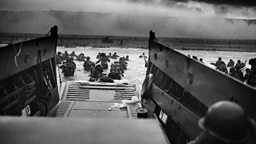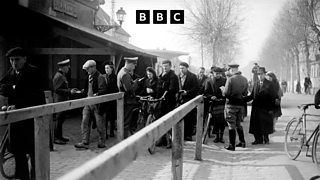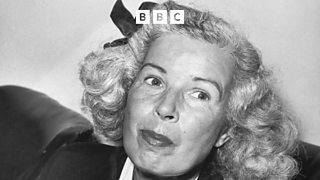The woman who changed the date of D-Day
The date of D-Day – 6 June 1944 - is now firmly fixed in the history books.
But Operation Overlord should have taken place 24 hours earlier. And it was partly thanks to a young Irishwoman called Maureen Flavin that the timing changed.
Maureen worked as an assistant postmistress in Blacksod on the far west coast of Ireland.
But her job wasn’t just stamping letters and sorting parcels. She also had to record weather readings using equipment set up outside the remote, rural post office.
Good night's sleep
"The reports from here showed the first changes. Wind direction was very important. You’d have to be precise with that. And living here we’d know the wind directions off by heart," Maureen explained, in an interview for a New Decade TV documentary in 2019.
"You went out at ten to the hour, night and day. You couldn’t get a good night’s sleep. You’d get one weather report sent, and then it was time to go out and take another one."

(Photo: Maureen and her husband Ted. Credit: Family photo)
I used to be afraid of the Germans coming ashore at night"
Maureen shared the 24 hour shifts with Margaret Sweeney, who ran the post office, and Margaret’s son Ted. Every hour, they phoned their readings to the weather office in Dublin.
"I didn’t like the night duty. I used to be afraid of the Germans coming ashore at night."
Meanwhile in the south of England, tens of thousands of British, American, and Canadian servicemen were gathering for the most ambitious operation of the war. The assault of the Normandy beaches.
The Allies - led by the US General, Dwight Eisenhower – had settled on a date. The invasion was set for 5 June 1944. But they needed clear skies and calm seas to land troops safely in France. Weather reports were vital.

(Photo: Weather station. Credit: Family photo)
Back in Blacksod, on 3 June, Maureen went to take her usual readings. It was one o’clock in the morning and it was an important day, for many reasons.
Her son Edward Sweeney explains: "It was her 21st birthday. At the time things were pretty spartan, they wouldn’t have been going out for a meal or anything.
"She was working – doing her shifts. And she actually took the reading that showed the weather changes coming in from the Atlantic. The barometer was dropping rapidly and a sharp, sudden wind was coming in. The storm was going to be quite severe."
Maureen wrote down her figures and phoned Dublin. What she didn’t know is that all her readings were being fed to the Allied headquarters in England, thanks to a deal that Britain had made with the neutral Irish government at the beginning of the war.
"And I was only just sat down when the phone rang.” Maureen remembered. "The call was from the Met Office in London. They needed to check the readings.
"I said: 'What’s wrong?' and of course they weren’t going to tell me they were going to war."
D-Day would have to be postponed
Maureen’s report – now double checked – was the first indication of the coming storm. Other weather reports followed.
At Allied headquarters, Group Captain James Stagg, the chief meteorologist, pulled all of the information together, and warned Eisenhower: D-Day would have to be postponed.
"The problem was the landing craft weren't capable of handling that sort of bad weather on the beaches,” Edward explains. "It would have involved large loss of life."
But there was still an important question. How quickly would the storm pass?

(Photo: D-Day landings. Credit: Photo12/Universal Images Group via Getty Images)
More readings came from the post office at Blacksod. Better weather was following the next day.
Operation Overlord went ahead on 6 June. In the first 24 hours, 160,000 Allied troops landed on a 50-mile stretch of Normandy coast. It was the start of the most pivotal battle of World War Two.
Very proud
At the time, Maureen never knew the significance of her 21st birthday weather report. Historians only discovered it a decade later.
By that time Maureen had married Ted Sweeney, was raising a family and had taken over as Backsod’s postmistress.
But in 2021, she received international recognition – a medal from the United States Congress.
"I’m very, very happy about it - that we did give the right readings," she recalled. “I felt proud. Very proud that it was from Blacksod and that we gave it right."
Maureen died in 2023, at the age of 100.

(Photo: Maureen with her medal. Credit: Family photo)
More WW2 stories from Witness History
-
![]()
Saving lives on D-Day
Charles Norman Shay was honoured for saving men from drowning on Omaha Beach
-
![]()
The WW2 escape line that fooled the Nazis
In 1940 a daring rescue operation began to help Allied servicemen escape from Nazi-occupied France
-
![]()
Axis Sally: World War II traitor who broadcast for the Nazis
In 1949, Mildred Gillars became the first woman in American history to be convicted of treason
-
![]()
French child evacuees of World War Two
In World War Two, tens of thousands of children left Paris to escape the threat of bombs





